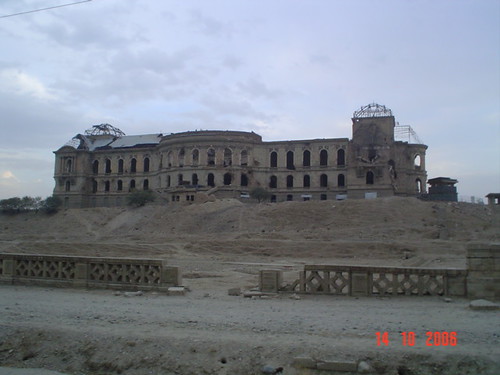The Darulaman Palace was built in the 1920s by former King Amanullah Khan as part of his plan for social and political modernization. It originally was intended to house Afghanistan's first elected parliament. But before that legislature could be created, Amanullah Khan was forced into exile by conservative Pashtun tribesmen who opposed his reforms.
The bombed-out ruins of the Darulaman Palace tower over the landscape to the south of Kabul. Sitting on a hilltop with its pockmarked portico balconies and Corinthian columns, it is a postcard image that has come to symbolize the destruction of Kabul during the civil wars of the 1990s.
Long before it was gutted in the early 1990s, the Darulaman Palace had been a symbol of a different kind.
When it was designed in the 1920s by European architects, the structure was meant to symbolize King Amanullah Khan's plans for democratic modernization -- plans that ultimately failed when Islamic conservatives led a series of uprisings against him in late 1928 and he fled to Europe.
Economy Minister Mohammad Amin Farhang said the Afghan government wants to restore the three-story building to its classical European grandeur so that after more than 75 years, it finally can be used for its original intended purpose.
"The Afghan government has decided that Darulaman Palace should be prepared for the Afghan parliament because, during the time of Amanullah Khan, the building was built for democracy," Farhang said. "And now, this palace should be used for democracy."
Many Afghans today are unaware of Darulaman Palace's significance as a symbol of modern democratic aspirations.
The country's first written constitution was promulgated by Amanullah Khan in 1923. It guaranteed personal freedom and equal rights of all Afghans. It also called for provincial councils to be created across Afghanistan with half of all members winning their seats through elections.
In his drive for modernization, Amanullah Khan established diplomatic and economic relations with major European and Asian states. He founded schools where classes were taught in French, German and English. And he built a new town to the south of Kabul -- named Darulaman, or "Abode of Peace" -- as Afghanistan's new administrative center.
Construction of his monumental Darulaman Palace for a future parliament was just part of the project. A structure for Kabul's municipal administration also was built nearby. A narrow-gauged railroad led to the center of Kabul about 10 kilometers away. Smaller government buildings and residential villas also were built for members of a newly established judiciary and for high-level government officials.
But the high cost of modernization -- and the king's efforts to reduce the power of Islamic clerics -- caused resentment among conservative Islamists and Pashtun tribal leaders.
The reformer king faced a series of tribal uprisings after he introduced reforms in the summer of 1928 that allowed women to be seen in public without head scarves or the all-encompassing burqa. At the beginning of 1929, just six months after announcing those reforms, Amanullah Khan was forced to renounce the throne and flee across the border into British Colonial India.
Darulaman Palace was destroyed when rival mujahedin factions fought for control of Kabul during the early 1990s.
With Amanullah Khan's downfall, Darulaman ceased being the Afghan capital. The municipal building eventually was converted into the Kabul Museum, whose ancient collections were looted in the early 1990s by militia factions and vandalized in the late 1990s by the Taliban regime.
Darulaman Palace was first gutted by fire in 1969. It was restored to house the Defense Ministry during the 1970s and 1980s. But it was destroyed again as rival mujahedin factions fought for control of Kabul during the early 1990s.
Today, parts of Darulaman Palace are used by NATO troops as an observation post.
Afghan officials say laws on the protection of Afghanistan's national heritage make it their duty to protect the historical identity of Darulaman Palace. They also say that moving the parliament to Darulaman -- which is now a district of the capital -- will help alleviate chronic traffic jams in the city center. But they say funds for the reconstruction must come from private donors rather than the cash-strapped state budget.
http://www.rferl.org/featuresarticle/2005/04/1aa388c3-a4bc-45da-af8b-44d88e888640.html
Thursday, October 26, 2006
Darulaman Palace
Labels:
Afghanistan,
history,
holiday,
war
Subscribe to:
Post Comments (Atom)


No comments:
Post a Comment